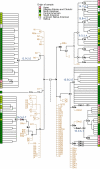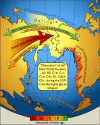Beringian standstill and spread of Native American founders
- PMID: 17786201
- PMCID: PMC1952074
- DOI: 10.1371/journal.pone.0000829
Beringian standstill and spread of Native American founders
Abstract
Native Americans derive from a small number of Asian founders who likely arrived to the Americas via Beringia. However, additional details about the initial colonization of the Americas remain unclear. To investigate the pioneering phase in the Americas we analyzed a total of 623 complete mtDNAs from the Americas and Asia, including 20 new complete mtDNAs from the Americas and seven from Asia. This sequence data was used to direct high-resolution genotyping from 20 American and 26 Asian populations. Here we describe more genetic diversity within the founder population than was previously reported. The newly resolved phylogenetic structure suggests that ancestors of Native Americans paused when they reached Beringia, during which time New World founder lineages differentiated from their Asian sister-clades. This pause in movement was followed by a swift migration southward that distributed the founder types all the way to South America. The data also suggest more recent bi-directional gene flow between Siberia and the North American Arctic.
Conflict of interest statement
Figures


Similar articles
-
Distinctive Paleo-Indian migration routes from Beringia marked by two rare mtDNA haplogroups.Curr Biol. 2009 Jan 13;19(1):1-8. doi: 10.1016/j.cub.2008.11.058. Curr Biol. 2009. PMID: 19135370
-
Large scale mitochondrial sequencing in Mexican Americans suggests a reappraisal of Native American origins.BMC Evol Biol. 2011 Oct 7;11:293. doi: 10.1186/1471-2148-11-293. BMC Evol Biol. 2011. PMID: 21978175 Free PMC article.
-
Y Chromosome Sequences Reveal a Short Beringian Standstill, Rapid Expansion, and early Population structure of Native American Founders.Curr Biol. 2019 Jan 7;29(1):149-157.e3. doi: 10.1016/j.cub.2018.11.029. Epub 2018 Dec 20. Curr Biol. 2019. PMID: 30581024
-
The late Pleistocene dispersal of modern humans in the Americas.Science. 2008 Mar 14;319(5869):1497-502. doi: 10.1126/science.1153569. Science. 2008. PMID: 18339930 Review.
-
Population genetics, history, and health patterns in native americans.Annu Rev Genomics Hum Genet. 2004;5:295-315. doi: 10.1146/annurev.genom.5.061903.175920. Annu Rev Genomics Hum Genet. 2004. PMID: 15485351 Review.
Cited by
-
Environmental conditions associated with initial northern expansion of anatomically modern humans.Nat Commun. 2024 May 22;15(1):4364. doi: 10.1038/s41467-024-48762-8. Nat Commun. 2024. PMID: 38777837 Free PMC article.
-
New age constraints for human entry into the Americas on the north Pacific coast.Sci Rep. 2024 Feb 21;14(1):4291. doi: 10.1038/s41598-024-54592-x. Sci Rep. 2024. PMID: 38383701 Free PMC article.
-
Maternal ancestry and lineages diversity of the Santander population from Colombia.Forensic Sci Res. 2023 Sep 21;8(3):241-248. doi: 10.1093/fsr/owad032. eCollection 2023 Sep. Forensic Sci Res. 2023. PMID: 38221971 Free PMC article.
-
New Y-SNPs in QM3 indigenous populations of Colombia.PLoS One. 2023 Dec 6;18(12):e0294516. doi: 10.1371/journal.pone.0294516. eCollection 2023. PLoS One. 2023. PMID: 38055663 Free PMC article.
-
Nuclear genetic diversity of head lice sheds light on human dispersal around the world.PLoS One. 2023 Nov 8;18(11):e0293409. doi: 10.1371/journal.pone.0293409. eCollection 2023. PLoS One. 2023. PMID: 37939041 Free PMC article.
References
-
- Bandelt HJ, Hernnstadt C, Yao YG, Kong QP, Kivisild T, et al. Identification of Native American founder mtDNas through the analysis of complete mtDNA sequences: some caveats. Ann Hum Genet. 2003;67:512–524. - PubMed
Publication types
MeSH terms
Substances
LinkOut - more resources
Full Text Sources


